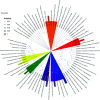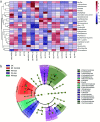Bioremediation of cadmium-contaminated paddy soil using an autotrophic and heterotrophic mixture
- PMID: 35519775
- PMCID: PMC9055442
- DOI: 10.1039/d0ra03935g
Bioremediation of cadmium-contaminated paddy soil using an autotrophic and heterotrophic mixture
Abstract
Cadmium (Cd) pollution poses a serious risk to human health and ecological security. Bioremediation can be a promising and effective remediation technology for treating Cd contaminated soils. In this study, seven heterotrophic strains were isolated from Cd contaminated soil and 7 autotrophic strains were isolated from acid mine drainage. Cd removal efficiencies were compared after leaching with autotrophic bacteria (Att-sys), heterotrophic isolates (Htt-sys) and cooperative leaching systems (Co-sys) in laboratory agitating reactors. The results indicated that Cd removal efficiency of Co-sys (32.09%) was significantly higher than that of Att-sys (23.24%) and Htt-sys (0.74%). By analyzing the soil microbial community in different bioleaching systems, we found that the addition of heterotrophic isolates significantly promoted the growth of some heavy metal resistant inhabitants (Massilia, Alicyclobacillus, Micromonospora, etc.), and Co-sys had a minor effect on the growth of soil indigenous microbes. In Co-sys, the content of the four Cd fractions all decreased compared with other leaching systems. The analysis of soil physicochemical parameters during the leaching process showed that pH and ORP (oxidation reduction potential) were not the only determinants for Cd removal efficiency in Co-sys, synergistic metabolic activities of autotrophic and heterotrophic strains may be other determinants. This study demonstrated that cooperative bioremediation may prove to be a safe and efficient technique for field application in heavy metal soil pollution.
This journal is © The Royal Society of Chemistry.
Conflict of interest statement
The authors declare no competing financial interest.
Figures





Similar articles
-
The Effect of Cysteine on the Removal of Cadmium in Paddy Soil by Combination with Bioremediation and the Response of the Soil Microbial Community.Toxics. 2024 Dec 29;13(1):22. doi: 10.3390/toxics13010022. Toxics. 2024. PMID: 39853022 Free PMC article.
-
Bioremediation of paddy soil with amphitropic mixture markedly attenuates rice cadmium: Effect of soil cadmium removal and Fe/S-cycling bacteria in rhizosphere.Sci Total Environ. 2024 Mar 10;915:169876. doi: 10.1016/j.scitotenv.2024.169876. Epub 2024 Jan 6. Sci Total Environ. 2024. PMID: 38185152
-
Application of mixotrophic acidophiles for the bioremediation of cadmium-contaminated soils elevates cadmium removal, soil nutrient availability, and rice growth.Ecotoxicol Environ Saf. 2022 May 1;236:113499. doi: 10.1016/j.ecoenv.2022.113499. Epub 2022 Apr 8. Ecotoxicol Environ Saf. 2022. PMID: 35405525
-
Interactions of the metal tolerant heterotrophic microorganisms and iron oxidizing autotrophic bacteria from sulphidic mine environment during bioleaching experiments.J Environ Manage. 2016 May 1;172:151-61. doi: 10.1016/j.jenvman.2016.02.041. Epub 2016 Mar 2. J Environ Manage. 2016. PMID: 26942859
-
[Interactions among soil biota and their applications in synergistic bioremediation of heavy-metal contaminated soils].Sheng Wu Gong Cheng Xue Bao. 2020 Mar 25;36(3):455-470. doi: 10.13345/j.cjb.190598. Sheng Wu Gong Cheng Xue Bao. 2020. PMID: 32237540 Review. Chinese.
Cited by
-
Recent Advances in Microbial-Assisted Remediation of Cadmium-Contaminated Soil.Plants (Basel). 2023 Aug 31;12(17):3147. doi: 10.3390/plants12173147. Plants (Basel). 2023. PMID: 37687393 Free PMC article. Review.
-
Bio-chelate assisted leaching for enhanced heavy metal remediation in municipal solid waste compost.Sci Rep. 2024 Jun 20;14(1):14238. doi: 10.1038/s41598-024-65280-1. Sci Rep. 2024. PMID: 38902389 Free PMC article.
-
A review on the bioleaching of toxic metal(loid)s from contaminated soil: Insight into the mechanism of action and the role of influencing factors.Front Microbiol. 2022 Dec 7;13:1049277. doi: 10.3389/fmicb.2022.1049277. eCollection 2022. Front Microbiol. 2022. PMID: 36569074 Free PMC article. Review.
-
The Effect of Cysteine on the Removal of Cadmium in Paddy Soil by Combination with Bioremediation and the Response of the Soil Microbial Community.Toxics. 2024 Dec 29;13(1):22. doi: 10.3390/toxics13010022. Toxics. 2024. PMID: 39853022 Free PMC article.
-
Fungi Can Be More Effective than Bacteria for the Bioremediation of Marine Sediments Highly Contaminated with Heavy Metals.Microorganisms. 2022 May 9;10(5):993. doi: 10.3390/microorganisms10050993. Microorganisms. 2022. PMID: 35630436 Free PMC article.
References
LinkOut - more resources
Full Text Sources

